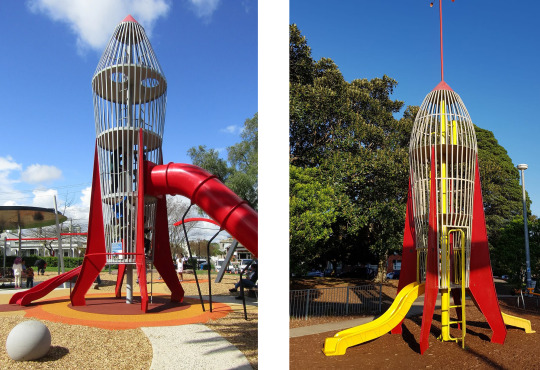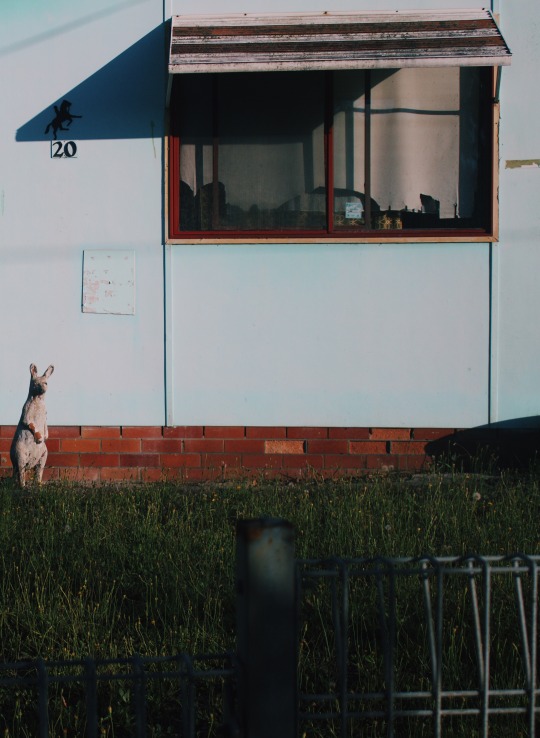Not on any tourist postcard. Est. 2015. On Darkinjung country.
Don't wanna be here? Send us removal request.
Text
Long Jetty, the Playground Rocket & the Space Age: Inspiring Future Coastie-Nauts
Coastal Incidental by Art.
31 March 2023

Credit: Coastal Incidental
After many decades’ stationary on the launch pad, the iconic red, blue and yellow playground rocket of Long Jetty on Darkingjung country finally had its T-minus 3, 2, 1, LIFT OFF.
While not exactly heading for the blanket of stars we are familiar with on the coast, the rocket more humbly made its way along The Entrance Road, where it will be taken for what Central Coast Council (CCC) calls a ‘planned refreshment’.
Not so much a nip and tuck, more a paint job and bringing the rocket up to twenty-first century safety standards.
You can vote on the future look and design of the rocket until 5 April. The revamped rocket will return in June.
Before talking about design options and how to vote, let's take 'one giant leap' back and chat about how Long Jetty's rocket arose from the 1960s quest to land on the Moon – and how the rocket's return is an opportunity to inspire the next generation on the coast to reach for the stars.

Credit: Central Coast Council
Playground rockets – symbolic of the first space age
When Apollo 11 astronaut, Neil Armstrong, disembarked from the lunar module to take 'one small step' onto the Moon's surface in 1969, children were also disembarking from rocket ships onto the grass, dirt and even concrete of playgrounds worldwide.
Rocket ships – like the one in Long Jetty – were increasingly constructed in playgrounds from the US to the then USSR, symbolic of the space race between these countries to reach the Moon and capture the imagination of the next gen.
The first playground rocket was built in Blackheath in the early 1960s after John Yeaman, a town engineer from the area, visited the US and was inspired to recreate the iconic playground equipment, with the help of metal manufacturer, Dick West.
Space archaeologist, Associate Professor Alice Gorman (also known as Dr Space Junk), has been researching the significance of and maintains a database of these unique playground structures. Nearly 40 rocket ships were constructed here.

Credit: Rotary Club of Blackheath
This period also saw the start of futuristic, space-inspired buildings and signage, known as Googie architecture. In the US, roadside diners in a hyper-modern style – think of the steel, neon and glass architecture from the cartoon, The Jetsons – sprung up to capture the attention (and dollars) of a new market: the car traveller.
Closer to home, the UFO-like The Shine Dome (or the 'Martian Embassy' as it is also known) was built in Canberra on Ngunnawal country. Home to the Australian Academy of Science, the design by architect, Roy Grounds, speaks to a technologically modern future.
Indeed, on Wiradjuri country, the Parkes radio telescope – now known as Murriyang, a name chosen by Wiradjuri Elders representing ‘Skyworld’ – was integral to televising the grainy footage of the Moon landing to over half a billion people worldwide.

Credit: Unknown. Original newspaper clipping from a scrapbook belonging to this blog's author.
Against this backdrop, countries from around the world were meeting at the United Nations to decide on the legal rules for the exploration and use of outer space. Lofty ideals on the exploration and use of outer space for the benefit of all, and to be used only for peaceful purposes infuse these laws.
Yet, the focus on outer space was subject to important critiques, considering the ongoing inequality and discrimination on Earth. The historical context of the Moon landing era cannot be overlooked. Civil rights movements during this era were pushing for the intersecting aims of racial equality, land rights for Indigenous peoples, gender equality and socioeconomic justice. Some of these sentiments in relation to the Moon landing were powerfully captured at the time by spoken poet Gil Scott-Heron.
The return of the rocket ship: an opportunity to inspire?
Along with the rocket refresh, CCC is looking to install an information board to ‘highlight the rocket’s life throughout the years’.
Let’s use this information board to not only talk about the local history of the rocket and how its symbolic of the first space age and the quest to reach the Moon, but importantly the return of the rocket ship can inspire the imaginations of the next generation.
A new space age is now underway. NASA is again working in cooperation with countries and companies across the world to return to the Moon and onto Mars. This 'Space 2.0' needs not only tech-minded people with science, technology, engineering and maths (STEM) skills, but poets, artists and philosophers to ask the big questions.
What does a future in outer space look like? How do we imagine and make real an outer space for all? How do we envision new ways of being and avoid exporting terrestrial inequalities?

The Earth rising behind the Moon, captured in 2022.
Credit: NASA
If you are asking: ‘Why care about outer space?’ One reason is that space technology helps us here on Earth. Satellites provide us with everything from images to help with weather monitoring and bushfire management to allowing us to speak instantly with loved ones next door or overseas.
So many technologies that we take for granted today had their origins in what scientists and engineers invented for outer space – from solar cell technology to freeze-dry food techniques to emergency thermal space blankets.
Let’s vote: the future design of the rocket
Fast forward five decades and very few of these playground rockets remain.
A council attempt to remove a rocket from a Hawthorn playground in Naarm, Victoria led to a petition garnering thousands of signatures. The rocket was saved and brought up to meet safety standards, and a series of jumpable boulders representing planets from the solar system were added. The rocket was re-opened in late 2022.

Hawthorn revamp (left), Enmore Park upgrade (right)
Credit: The Glenferrie Times
Fortunately, CCC is keeping the local icon and asking for resident views on the future design by April 5. The options:
(1) Keep it classic with only the necessary safety repairs; or
(2) Upsize the rocket with an extra slide and make changes to enable the top portion of the equipment to re-open.
Get voting here.
While partial to retaining the ‘classic look’ (option 1), this blog encourages CCC to look at other refreshed rockets such as the one in Hawthorn or Enmore Park to inform any revamped design for option 2, if not already done so.
Let’s hope the return of the rocket can inspire and fuel space enthusiasts – and potentially even a future local astronaut (or ‘coastie-naut’) towards a real life T-minus 3, 2, 1 LIFT OFF.
-
Established in 2015, Coastal Incidental is an arts project to engage locals and tourists alike on the NSW Central Coast on Darkinjung country with the area’s changing built environment. Initially a photography project, the project has grown to include walking tours, talks, exhibitions and zines, with involvement in local community events such as the Long Jetty Street Fest, Blank Canvas pop-ups and the Neighbourhoods art trails.
To say hello: [email protected]
With special thanks to Linda Coy for encouraging this blog post.
-
Copyright © 2023 Coastal Incidental.
0 notes
Text
0 notes
Text
0 notes
Text
0 notes
Photo

fibro classic.
0 notes
Photo

The spread of suburbia brings repetition to the landscape.
0 notes










